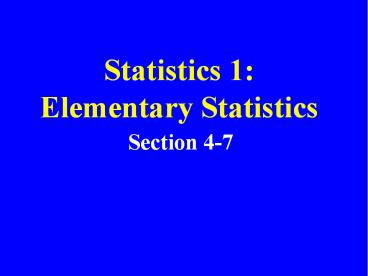Statistics 1: Elementary Statistics - PowerPoint PPT Presentation
Title:
Statistics 1: Elementary Statistics
Description:
Statistics 1: Elementary Statistics ... Rule Factorial Rule Permutations Rule Permutations ... Permutations Rule Permutations Rule #2 Combinations Rule ... – PowerPoint PPT presentation
Number of Views:143
Avg rating:3.0/5.0
Title: Statistics 1: Elementary Statistics
1
Statistics 1Elementary Statistics
- Section 4-7
2
Probability
- Chapter 3
- Section 2 Fundamentals
- Section 3 Addition Rule
- Section 4 Multiplication Rule 1
- Section 5 Multiplication Rule 2
- Section 6 Simulating Probabilities
- Section 7 Counting
3
Learning to Count
- Why do we need to learn to count?
- We approach probability through the doorway of
relative frequency
4
Learning to Count
- Count ways for A s
- Count all ways n
- Probability s/n
5
Five Counting Rules
- Fundamental Counting Rule
- Factorial Rule
- Permutations Rule
- Permutations Rule when some items are identical
to others - Combinations Rule
6
Fundamental Counting Rule
- Event A can happen in m ways
- Event B can happen in n ways
- Then A and B can happen together in (m)(n) ways
- Examples
7
Fundamental Counting Rule Examples
- Dice
- 1st die can happen in 6 ways
- 2nd die can happen in 6 ways
- the two dice can happen in (6)(6)36 ways
- Birthday example
8
Factorial Rule
- If there are N distinct items, they can be
arranged in N! different sequences - Synonyms sequences, orders, arrangements
9
Factorial Rule
- Calculator use for factorials
10
Permutations Rule
- There are N distinct items
- You could form different distinct sequences of
size r (sequence matters) - How many?
11
Permutations Rule
- Using the calculator function for permutations
12
Permutations Rule 2
- You have N items made up of k groups, and
within each group the items are not distinct. - The N items together can form this many distinct
sequences
13
Combinations Rule
- There are N distinct items
- You could form different combinations of size r
for which the sequence does not matter - How many?
14
Combinations Rule
- Using the calculator function for combinations































